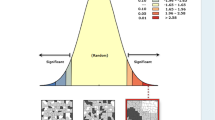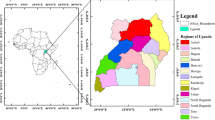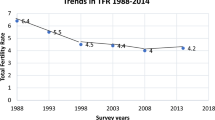Abstract
Fertility in sub-Saharan Africa is among the highest globally and relatively higher in West Africa compared to the other sub-regions of Africa. While there have been extensive studies on fertility in West Africa, the underlying spatial variations with regard to within and cross-border variations among countries has received little attention. This study examined spatial variations in fertility desire among thirteen (13) West African countries using data from the most recent Demographic and Health Survey conducted between 2010 and 2018. The analysis considers two fertility indicators; preference for another child and ideal number of children, and the spatial units were the states/regions/provinces of the countries included in the study. Bayesian spatial models were specified for the count and multi-categorical response variables respectively, with the use of Markov random field prior for the spatial components while Markov chain Monte Carlo simulation technique was used for parameter estimation. The findings suggest spatial clustering in fertility desire both within and between countries, revealing cross-border spatial contagion. Specifically, women report high number of children as ideal throughout Niger extending to neighbouring northern Nigeria, in Mopti and Koulikoro regions of Mali; in Couffo region of Benin; in Kaffrine region of Senegal and all except Basse region of The Gambia. Additionally, being young, having low or no formal education, living in poor households, being a rural dweller and not using contraceptives were negatively associated with fertility desire. Policies aimed at reducing fertility should consider the spatial dynamics in addition to targeting younger, less educated, rural dwelling women while also strengthening sensitization campaigns for family planning.







Similar content being viewed by others
References
Abiodun, O. M., & Balogun, O. R. (2009). Sexual activity and contraceptive use among young female students of tertiary educational institutions in Ilorin, Nigeria. Contraception, 79(2), 146–149.
Adegoke, T. G. (2010). Socio-cultural factors as determinants of divorce rates among women of reproductive age in Ibadan Metropolis, Nigeria. Stud Tribes Tribals Tribes Tribals, 8(2), 107–114.
Adhikari, R. (2010). Demographic, socio-economic, and cultural factors affecting fertility differentials in Nepal. BMC Pregnancy and Childbirth, 10, 1–11.
Alaba, O. O., Olubusoye, O. E., & Olaomi, J. O. (2017). Spatial patterns and determinants of fertility levels among women of childbearing age in Nigeria. South African Family Practice, 59(4), 143–147.
Amusa, L., & Waheed, Y. (2019). Stepwise geoadditive modelling of the ideal family size in Nigeria. Turkiye Klinikleri Journal of Biostatistics, 11(2), 123–32.
Arthur, J. A. (1991). International labor migration patterns in West Africa. African Studies Review, 34, 65–87.
Atake, E. H., & Ali, P. G. (2019). Women’s empowerment and fertility preferences in high fertility countries in Sub-Saharan Africa. BMC Women’s Health, 19(1), 1–14.
Bailey, M., and Weller, R. H. (1987) “Fertility differentials in rural Sierra Leone : A path analysis published by : College of Business, Tennessee State University Stable URL : Https://Www.Jstor.Org/Stable/4191540 Fertility Differentials in Rural Sierra Leone : A Path Analysis.” The Journal of Developing Areas 21(2): 191–208
Bandehelahi, K., Khoshravesh, S., Barati, M., & Tapak, L. (2019). Psychological and sociodemographic predictors of fertility intention among childbearing-aged women in Hamadan, West of Iran: An application of the BASNEF model. Korean Journal of Family Medicine, 40(3), 182–187.
Christiane, B. et al. 2015. BayesX - Bayesian inference in structured additive models. Bayex. http://www.uni-goettingen.de/de/bayesx/550513.html (May 29, 2020).
Bongaarts, J. (2017a). Africa’s unique fertility transition. Population and Development Review, 43, 39–58.
Bongaarts, J. (2017b). The effect of contraception on fertility: Is Sub-Saharan Africa different? Demographic Research, 37(1), 129–146.
Bremhorst, V., Kreyenfeld, M., & Lambert, P. (2016). Fertility progression in Germany: An analysis using flexible nonparametric cure survival models. Demographic Research, 35(1), 505–534.
Brooks, M. I., et al. (2019). Can community health workers increase modern contraceptive use among young married women? A cross-sectional study in rural Niger. Reproductive Health, 16(1), 1–10.
Caldwell, J. C., & Pat, Caldwell. (1987). The cultural context of high fertility in Sub-Saharan Africa. Population and Development Review, 13(3), 409–437.
Casterline, J. B. (2017). Prospects for fertility decline in Africa. Population and Development Review, 43, 3–18.
Casterline, J. B., & Agyei-Mensah, S. (2017). Fertility desires and the course of fertility decline in Sub-Saharan Africa. Population and Development Review, 43, 84–111.
Casterline, J. B., & Han, S. (2017). Unrealized fertility: fertility desires at the end of the reproductive career. Demographic Research, 36(1), 427–454.
Casterline, J. B., and Laila O. El-Zeini. 2017. The Estimation of Unwanted Fertility Author (s): John B. Casterline and Laila O. El-Zeini Published by : Springer on Behalf of the Population Association of America Stable URL : Http://Www.Jstor.Org/Stable/30053115 JSTOR Is a Not-for-Profit Service Th. Demography 44(4): 729–45.
Cleveland, D. A. (1991). Migration in West Africa: A Savanna village perspective. Africa J Int African Inst, 61, 222–246.
Channon, M. D., & Harper, S. (2019). Educational differentials in the realisation of fertility intentions: Is Sub-Saharan Africa Different? PLoS ONE, 14(7), 1–14.
Ciritel, A. A., De Rose, A., & Arezzo, M. F. (2019). Childbearing intentions in a low fertility context: The case of Romania. Genus, 75(1), 4. https://doi.org/10.1186/s41118-018-0046-6.
Dow, T. E. (1971). Fertility and family planning in Sierra Leone. Studies in Family Planning, 2(8), 153–165.
Ewemooje, O. S., Biney, E., & Amoateng, A. Y. (2020). Determinants of fertility intentions among women of reproductive age in South Africa: Evidence from the 2016 demographic and health survey. Journal of Population Research, 37, 265–289.
Fahrmeir, L., et al. (2013). Regression models methods and applications. Regression Models (pp. 21–72). Springer.
Finlay, J. E., Mejía-Guevara, I., & Akachi, Y. (2018). Inequality in total fertility rates and the proximate determinants of fertility in 21 Sub-Saharan African Countries. PLoS ONE, 13(9), 1–16.
Flahaux, M. L., & De Haas, H. (2016). African migration: Trends, patterns, drivers. Comparitive Migration Studies, 4, 1–25.
Garenne, M. (2017). Record high fertility in sub-Saharan Africa. African Population Studies, 31(2), 3706–3723.
Gayawan, E., Adarabioyo, M. I., Okewole, D. M., Fashoto, S. G., & Ukaegbu, J. C. (2016). Geographical variations in infant and child mortality in West Africa: A geo-additive discrete-time survival modelling. Genus, 72(1), 5. https://doi.org/10.1186/s41118-016-0009-8..
Gayawan, E., & Adebayo, S. B. (2013). A Bayesian semiparametric multilevel survival modelling of age at first birth in Nigeria. Demographic Research, 28(June), 1339–1372.
Hayford, S. R., & Agadjanian, V. (2012). From desires to behavior. Demographic Research, 26, 511–542.
Heywood, W., Pitts, M. K., Patrick, K., & Mitchell, A. (2016). Fertility knowledge and intentions to have children in a national study of Australian Secondary School Students. Australian and New Zealand Journal of Public Health, 40(5), 462–467.
Karabchuk, T. 2018. Center for economic institutions working paper series. Center for Economic institutions: 28.
Kim, J. 2016. Female education and its impact on fertility. IZA World of Labor (February): 1–10.
Kuhnt, A.-K, and Trappe, H. 2013. Easier said than done: childbearing intentions and their realization in a short term perspective. MPIDR working paper 49(0): 1–31.
Laelago, T., Habtu, Y., & Yohannes, S. (2019). Proximate determinants of fertility in Ethiopia; An application of revised Bongaarts model. Reproductive Health, 16(1), 1–9.
Lang, S., & Brezger, A. (2004). Bayesian P-splines. Journal of Computational and Graphical Statistics, 13(1), 183–212. https://doi.org/10.1198/1061860043010
Lerch, M. (2019). Regional variations in the rural-urban fertility gradient in the global South. PLoS ONE, 14, 1–18.
Machiyama, K., Mumah, J. N., Mutua, M., & Cleland, J. (2019). Childbearing desires and behaviour: A prospective assessment in Nairobi Slums. BMC Pregnancy and Childbirth, 19(1), 1–12.
Martin, T. C. (1995). Women’s education and fertility: Results from 26 demographic and health surveys. Studies in Family Planning, 26(4), 187–202.
Masanja, G. F., Lwankomezi, E., & Emmanuel, C. (2016). The effects of declining fertility on household socioeconomic conditions in Tanzania: A comparative study of urban versus rural areas of Kwimba District, Mwanza region. International Journal of Population Research, 2016, 1–14.
Matovu, J. K. B., Makumbi, F., Wanyenze, R. K., & Serwadda, D. (2017). Determinants of fertility desire among married or cohabiting individuals in Rakai, Uganda: A cross-sectional study. Reproductive Health, 14(1), 1–11.
Mbacké, C. (2017). The persistence of high fertility in sub-Saharan Africa: A comment. Population and Development Review, 43, 330–337.
Meggiolaro, S. (2008) Reproductive intentions : Individual and contextual determinants. (February).
Muhoza, D. N., Broekhuis, A., & Hooimeijer, P. (2014). Variations in desired family size and excess fertility in East Africa. International Journal of Population Research, 2014, 1–11.
Olaolorun, F., et al. (2016). Women’s fertility desires and contraceptive behavior in three Peri-Urban communities in Sub Saharan Africa. Reproductive Health, 13(1), 1–6.
Olatoregun, O., Fagbamigbe, A. F., Akinyemi, O. J., Oyindamola, B. Y., & Bamgboye, E. A. (2014). A comparative analysis of fertility differentials in Ghana and Nigeria. African Journal of Reproductive Health, 18(3), 36–47.
Phan, L. Y. (2016). Women’s empowerment and fertility changes. The University of Sydney, 39(1), 49–75.
Pradhan, A., & Pandey, S. (2010). Fertility desire of working women in Kathmandu. Journal of Nepal Health Research Council, 8(2), 95–98.
Robinson, W. C. (2020). Population investigation committee. The time cost of children and other household production Author (s): Warren C. Robinson Published by : Taylor & Francis, Ltd. on Behalf of the Population Investigation Committee Stable URL : Https://Www.Jstor.Org/St. 41(2): 313–23.
Rue, H., Held, L. (2005) Gaussian Markov random fields: Theory and applications - 1st Edition -. Boca Raton: Chapman & & Hall/CRC. https://www.routledge.com/Gaussian-Markov-Random-Fields-Theory-and-Applications/Rue-Held/p/book/9781584884323 (May 29, 2020).
Sato, Y. (2007). Economic geography, fertility and migration. Journal of Urban Economics, 61(2), 372–387.
Sinai, I., Omoluabi, E., Jimoh, A., & Jurczynska, K. (2019). Unmet need for family planning and barriers to contraceptive use in Kaduna, Nigeria: Culture, myths and perceptions. Culture, Health and Sexuality, 22(11), 1253–1268. https://doi.org/10.1080/13691058.2019.1672894.
Sow, P., Adaawen, S. A., & Scheffran, J. (2014). Migration, social demands and environmental change amongst the Frafra of Northern Ghana and the Biali in Northern Benin. Sustainability (Switzerland), 6(1), 375–398.
Speizer, I. S., & Lance, P. (2015). Fertility desires, family planning use and pregnancy experience: Longitudinal examination of urban areas in three African countries. BMC Pregnancy and Childbirth, 15(1), 1–13.
Takyi, B. K., & Taylor, P. (2001). Marital instability in an African society: Exploring the factors that influence divorce processes in Ghana. Sociological Focus, 34(1), 77–96.
Testa, M. R. (2014). On the positive correlation between education and fertility intentions in Europe: Individual- and country-level evidence. Advances in Life Course Research, 21, 28–42.
Testa, M. R., & Stephany, F. (2018). The educational gradient of fertility intentions: A meta-analysis of European studies. Vienna Yearbook of Population Research., 1, 293–330.
UNESA. 2015. World Fertility Patterns 2015.
United Nations. 2019. World population prospects 2019: Data booklet. Department of Economic and Social Affairs Population Division: 1–25.
Author information
Authors and Affiliations
Corresponding author
Ethics declarations
Conflict of interest
The authors declare no competing interests.
Additional information
Publisher's Note
Springer Nature remains neutral with regard to jurisdictional claims in published maps and institutional affiliations.
Appendix
Appendix
Rights and permissions
About this article
Cite this article
Gayawan, E., Dake, F., Dansou, J. et al. Spatial Variations in Fertility Desire in West Africa. Spat Demogr 10, 359–385 (2022). https://doi.org/10.1007/s40980-021-00088-5
Accepted:
Published:
Issue Date:
DOI: https://doi.org/10.1007/s40980-021-00088-5







